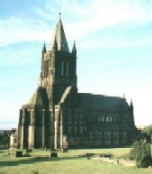|
|
-
FUGUE:
CHAPTER IX
AN
APPRECIATION OF THE ORGAN AS IT STANDS TODAY [1978]
|
In
assessing the merits of the Armley Schulze organ, there are
several points which must be borne in mind.
The
organ was never intended for a church, but was built for private
ownership as a concert instrument, only two pedal stops being
added when it was brought to Armley. It is therefore all the more
remarkable that the organ acquits itself so well in what is, after
all, its most important function to lead and to inspire the music
of the Anglican service.
This
organ was not originally envisaged as a whole, but grew piecemeal.
After being enlarged from a small two-manual and pedal organ to a
large three-manual and pedal instrument, the important Choir Organ
was added at the last stage when, in Schulze's words, "room
can be found for the same alongside the Echo, under the Swell."
The
Schulze firm built organs in the Romantic style, making it a prime
consideration "to obtain the richest possible selection of
fine solo stops" - from their letter describing the first
specification submitted to Kennedy. Both the relative scaling of
the stops and the voicing of the pipes differ radically from those
of a typical Baroque organ in which, for example, the flute pipes
become wide "tubs" in the treble, whilst the diapason
(or "principal") pipes of high pitch are very slender.
This contrast in scale-progression gives individuality to
the ranks, whereas at Armley they run in parallel, causing a
certain similarity between the quiet stops noted by Gilbert Benham
and Ralph Downes.
Although
the pipes and soundboards (except certain of the Pedal
soundboards) remain almost as Schulze left them, the whole
instrument is now (1985) played through a type of action unknown
to Schulze which, in its present state, disturbs the speech of the
Principal chorus to a considerable extent.
Why
is it that this organ is given a place amongst the finest in the
land? It is because it has a wonderful clarity and purity of tone
which allows the stops to be blended in seemingly endless
combinations of great beauty, from the gentle tones of the Echo
Organ to the brilliance and power of the Great Organ. Schulze
achieved this cohesion through his genius as a voicer and
finisher, giving his pipes as Dr. Pearson said "a clear,
pleasant, open, forward tone on the pure ah vowel model."25
To this must be added first the favourable position of the organ
on its noble gallery in the shallow but lofty north transept,
where every pipe has adequate speaking room, with the exception of
the Choir Organ, placed in front of the Echo Organ and at a lower
level than that of Great or Swell Organs, from which position its
tones are rather subdued. Secondly, the magnificent acoustics of
the crossing and lofty nave, with a reverberation period of 3¼
seconds in the empty church, greatly enhance the effect of the
instrument. As a whole, the organ is best heard from the nave
rather than from the console, since there the tones of individual
stops are more readily distinguished.
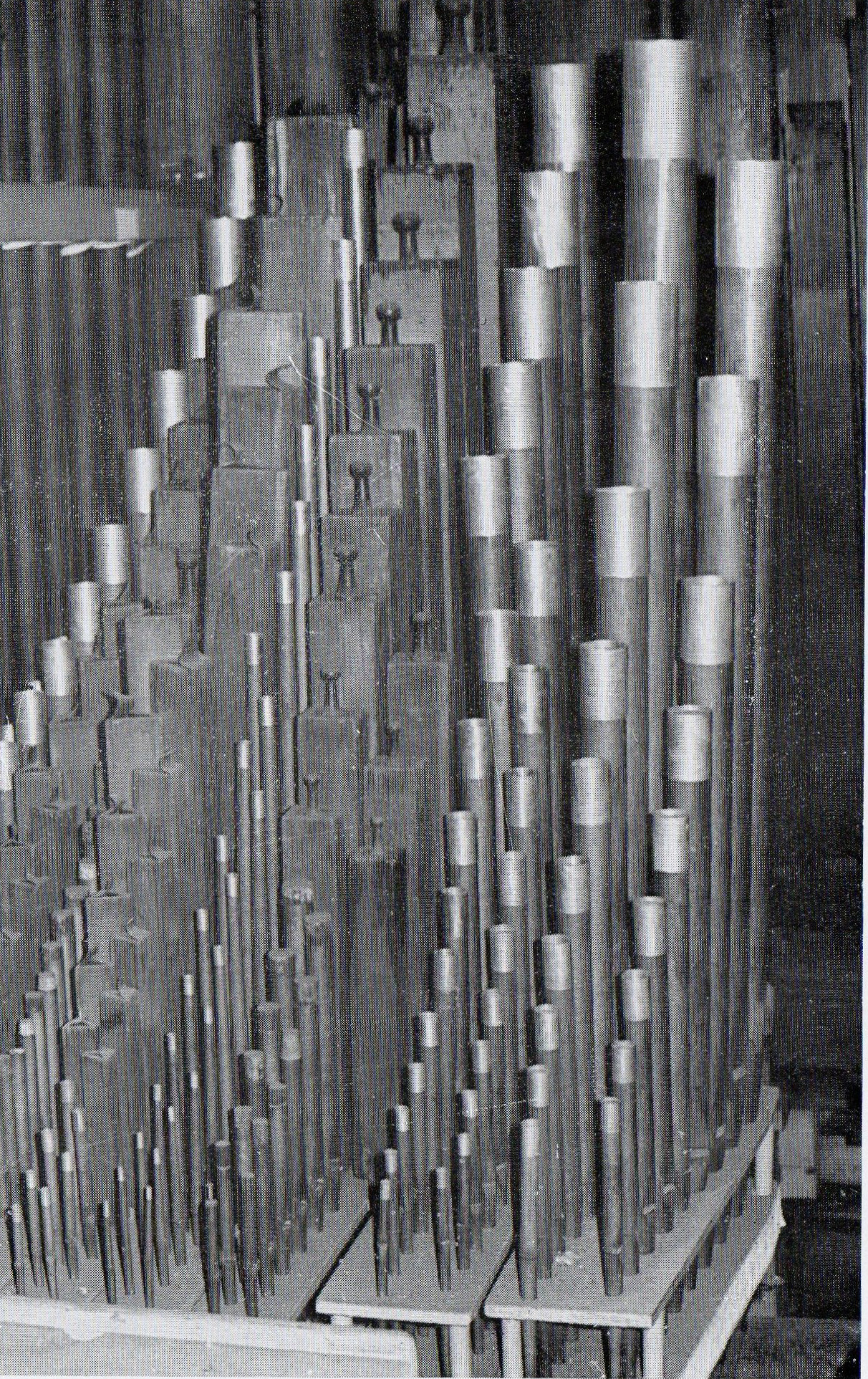
|
|
The
Great Organ, with supporting Pedal, was truly described by
that authority on English organs the late Gilbert Benham, as "a
thrilling sound of indescribable grandeur and majesty."
The Major Principal 8ft. with the bass octave of wooden pipes
always preferred for their tone by J. F. Schulze & Sons,
was described by Sir John Stainer as "a whole organ in
itself" when he first heard the stop and Ralph Downes
describes it as it was when he heard it in 1947 as having "a
breadth and nobility combined with a warm string-like bloom."
The Gemshorn 8ft. adds a little to the output of the Major
Principal and the acoustics of the church amplify these two
stops considerably, to take their fitting part in the rich,
well-balanced chorus of 16, 8, 8, 4, 2⅔ and 2ft. The Sub
Principal 16ft. has two bass octaves of wood and, although of
large scale, its tone has a remarkable softness that enables it
to take part in many combinations without upsetting the
balance, whilst giving much richness to the full Great. With an
octave of similar power, but slightly thinner in tone, and a
bold Rausch Quinte, a rich, powerful chorus results.
In
1921, J. J. Binns wrote to the Rev. N. A. Bonavia-Hunt as
follows:
“I
have just come across something in the Schulze organ at Armley
that will
surprise you. We have just cleaned the job and
put tuning slides on all metal pipes, and to my surprise I find
all the great, that isopen 16ft, open 8ft, principal 4 ft,
twelfth, fifteenth, and mixture five ranks, are all the same
scale as the open 8ft . . . And all are voiced so as to get
every bit of tone possible out of each pipe”.
Left:
The C side of the Great Organ soundboard, showing from right to
left the pipes of the Sub-Principal, Major Principal, Bordun,
Gemshorn, Hohl Flõte 8ft, Gedact, Hohl Flõte 4ft,
and Octave.
|
|
Bonavia-Hunt,
writing in 1933, said:
There
has existed in the past
a school of tonal design that works on the principle that no
portion of the spectrum should be particularly emphasized. In
this case, the effectiveness of the scheme would depend on a
vast dimension of tone. Perhaps the most signal instance of the
working out of this principle in England is that which occurs
in the organ at St. Bartholomew’s, Armley. Here, every
rank of pipes comprising the diapason chorus is scaled on the
basis of 21/8
in.
Diameter for the 2 ft. pipe, the mouth areas are constant
throughout the series, and the bores of the pipe feet are also
maximum size. The voicing
of the
various ranks, however, varies in t hose finer details which
the expert can detect”.
|
|

|
The
measurement of 21/8
in. diameter for the 2ft. pipes is,
however, misleading.
The scale of a pipe should strictly
refer to the internal diameter, and this is 115/16
in. (49 mm.) for middle C (2ft.) pipe of the Great Organ Major
Principal shown here, which, as observed by Boseley, is “of
great thickness and weight.” The external circumference
of this pipe and of the corresponding pipes of the Sub
Principal, Octave and the twelfth rank of the Rausch Quinte
are all 6.5 in. (165 mm.), equivalent to an external diameter
of 2.07 in. (52.5 mm.) or approximately 21/16
in, which is probably the explanation of Bonavia-Hunt’s
statement. Since Binns had just fitted tuning slides to the
pipes in question, he probably supplied the external diameters
(with which he would be concerned at the time) to
Bonavia-Hunt. The scale of the 2ft. pipe of the mixture is
slightly less, the external circumference being 6.0 in. (152
mm.), the external diameter 1.91 in. (48.5 mm.) and the
internal diameter 113/16
in. (46 mm.)
In this Principal chorus, the pipes reach
half measure at the sixteenth pipe above that selected for
measurement, as recommended by Töpfer, and as generally
used by Schulze.
Left: Mouth of Middle C
pipe, showing nicking of the languid, and great width of mouth
|
|
External
circumference: 165 mm
Internal diameter: 49 mm
Width
of mouth: 43 mm
Height of mouth: 11 mm
Diameter of
foot hole: 9. 5 mm
|
The
twelfth and fifteenth ranks are drawn as a single stop "Rausch
Quinte II fach" as shown on the original stop knob and as
appeared in both the early specifications by Schulze for
Meanwood. As explained in
chapter III, (page 4), there is no reason to
doubt that the ranks were always drawn together. This curious
feature, which also occurs in the larger Schulze organ at
Doncaster Parish Church and in the smaller Schulze organ at St.
Mary's Church, Tyne Dock, South Shields,* means that there
is no separate 2ft. diapason rank throughout the organ, and
indeed the only separate 2ft. rank in the instrument is the
Flautino of the Echo Organ.
|
|
The
two reed stops are both on the same wind pressure of 3¼ in.
as the flue stops and not on 4 in. wind as has been stated
elsewhere. They are free-toned stops which to some ears suggest
roughness when heard at the console, but heard from the nave, they
blend admirably with the Principal chorus, adding power and
colour, but without in any way dominating the chorus. The 16ft.
reed, in spite of its name, is not of Tuba tone!
*
[Pending the closure of St. Mary’s Church in 1980 the church
authorities, mindful of the importance of the organ, generously
donated it to Ellesmere College, Shropshire, where it was
installed in 1981.]
The Five-rank
Mixtur
This
stop has caused much controversy and even adverse criticism
because of the great increase in power which results when it is
added to Great to Fifteenth. It should be emphasized, however,
that this is more evident at the console than when heard from the
nave, partly because the Mixtur is at the front of the soundboard.
-
 The
5-rank Mixtur of the Great Organ (C sharp side) with the Tuba
and Trompete in the background. The top six notes of the
muxtur have 4 ranks only.
The
5-rank Mixtur of the Great Organ (C sharp side) with the Tuba
and Trompete in the background. The top six notes of the
muxtur have 4 ranks only.
|
|
In
the first specification from Schulze (13th September, 1866)
the Great Organ diapason chorus extends only to the Twelfth
and Fifteenth, drawn together, with a Bourdon 16ft. as manual
double. In the second specification (6th October, 1866) the
Great Organ is enlarged by the addition of a Mixtur 3 fach
(i.e. 3 ranks) of 183 pipes. Significantly however, in another
hand as already described "4 ranks" is written above
the Mixtur entry, and this together with the letter of the
23rd November, 1866, from Paulinzelle:
“We
are
likewise in agreement with you with regard to the Mixtur.
The
tone becomes fresher, especially with the low
notes.”
strongly
suggests that the insertion "4 ranks" was by
Kennedy, who probably suggested a fourth rank for the mixture
at this stage.
It
is unfortunate that the final specification, as agreed between
Kennedy and Edmund Schulze, has not been preserved, but since
the organ was to grow from a two-manual
and
pedal instrument to one of four
manuals
and
pedal, it is very probable that the Great Mixtur was increased
to five ranks at that time, possibly during one of Kennedy's
visit to Paulinzelle. Edmund Schulze's father had been
familiar with five and six rank mixtures at Bremen and Lübeck,
whilst the organ of Halberstadt Cathedral, rebuilt by the firm
in 1837-8 had, as new stops, a Mixtur 6 ranks, Scharf 4 ranks
and a Cornet 4 ranks in the Hauptwerk. The organ built by
Edmund Schulze in 1866 for the Tonhalle at Düsseldorf,
which was much admired by Kennedy and Broughton, had a Rausch
Quint 2 ranks, a Mixtur 5 ranks and a Cymbel 3 ranks on the
Great soundboard. Finally, the original stop knob, which has
been preserved, reads "Mixtur V fach", i.e.
five-fold mixture - not "Mixtur 5 fachs" as engraved
on the Binns ivory stop knob.
|
There
is no reason to suppose that there was any change in the
specification of the organ on its removal to Harrogate, where the
Press Reports clearly defined the Mixtur as having five ranks, and
it must therefore be assumed that the stop was so constituted when
at Meanwood. There is no evidence that it was modified later, as
has been suggested. Since the organ-chamber of the Meanwood
"chalet" was evidently rather cramped for the large
four-manual instrument, causing Edmund Schulze considerable
trouble to re-arrange the soundboards owing to the
misunderstanding about the width of space available, it is
reasonable to suppose that the Great Mixtur was given five ranks
to provide added power and brilliance for special effects. The
Rev. J. H. Burn suggested that there were in fact three "Full
Greats" (1) fluework and reeds without mixture; (2)
flue-work, including mixture, without mixture; (2) flue-work,
including mixture, without reeds; (3) flue-work with mixture and
reeds.
Dr.
T. E. Pearson, when organist of the church, confirmed J.J. Binns'
observations by his discovery that treble G, or any higher note,
played on the Mixtur with the quint rank silenced, is identical
with the same note played on the parent chorus of 8ft., 4ft.,
2⅔ft. and 2ft. stops. He considered that there is
too great an hiatus between Full Great and Full Great without the
mixture, and suggested that the latter should be reduced to 3
ranks from CC to tenor G, 4 ranks from tenor G to treble G,
remaining as 5 ranks from treble G upwards, thus removing the
higher harmonics over the range of the pedal-board where he found
them too prominent, but leaving the full five ranks in the treble
where "The effect is magnificent in its gorgeous
brilliance."
Fortunately
this and other changes suggested, such as the addition of a second
Principal chorus to build up to the Mixtur on the lines of Binns'
experiment with the added 8ft. rank, were never carried out and
the chorus remains as Schulze left it. As at Soest, where the
organ was so much admired by Allbutt and Kennedy, Schulze provided
a thrilling and powerful Great and Pedal at Meanwood, the other
departments of the organ being subsidiary in tonal output. Mr.
Arnold Mahon, the present organist, considers that there is too
great a difference in power between the major chorus of the Great
Organ and the softer ranks of that division.
The
Swell Organ is the only "enclosed" division of the
instrument and has an effective swell box, giving a good
crescendo. The Geigen Principal 8ft. and Octave 4ft. are beautiful
stops of cantabile tone, but the jump to the silvery Cymbel
is too great, again due to the absence of a separate 2ft. rank.
The delicate stops are of excellent quality, including two gentle
string-toned ranks and two flutes, together with the substituted
Celeste. The reeds lack the all-important 16ft. member, the
absence of which probably accounts both for the lack of "body"
in the Full Swell to English ears and for the lack of blend with
the 4-rank Cymbel noted by Pearson.
-
The
Choir Organ is a beautiful
miniature of the Great, with a Minor Principal 8 ft. as a
softer version of the Great Gemshorn and an Octave 4ft., but
again no separate 2ft. rank. During the 1956 renovation, the
pipes of the Piccolo 4ft. were transposed down an octave to
form a 2ft. stop, a new top octave being provided and the
bottom octave stored within the organ. This experiment was not
as successful as expected and was carried out without due
regard to the function of the Cornett 2-5 ranks. This contains
a tierce rank from tenor C upwards based
on the 16ft. pitch and it is now
thought that it was intended to serve not as a chorus mixture,
but for solo use with the Lieblich Bordun 16ft. and Piccolo
4ft., played an octave higher. Hence the Piccolo has been
reinstated at 4ft. pitch and it is probable that Schulze
intended that this stop should be played an octave higher when
a 2ft. rank was required, as he suggested when Kennedy
requested the insertion of a Flageolet 2ft. in the Oberwerk of
the second specification of October, 1866.
|
|
Right:
General view of the Choir Organ, with the
Clarinette in the foreground. Pipes are planted semitonally.
|

|
|
|
Mouth
of middle C pipe of Choir Organ, Cello und Violine
External
circumference 22 mm
Internal
diameter 31 mm
Width of mouth 22 mm
Height of mouth (max) 6.4 mm
|
|
The
Cello und Violine 8ft. (left) is an especially beautiful
stop, although rather slow in speech, showing Schulze's genius
in voicing wooden pipes to give string tone. It is matched in
quality by the Gedact 8ft., the Lieblich Flöte 4ft. and
the lovely Orchester Flöte 8ft. (right).
Like
the Echo Organ, the pipes of the Choir division are arranged
semitonally on the soundboard and the action was originally
mechanical (or tracker) to both Echo and Choir.
This
semitonal arrangement also existed in the Schulze Echo Organ at
Leeds Parish Church which was inserted in 1859 as the solo
Organ. As already explained, the Choir Organ appears rather
subdued owing to its position.
|
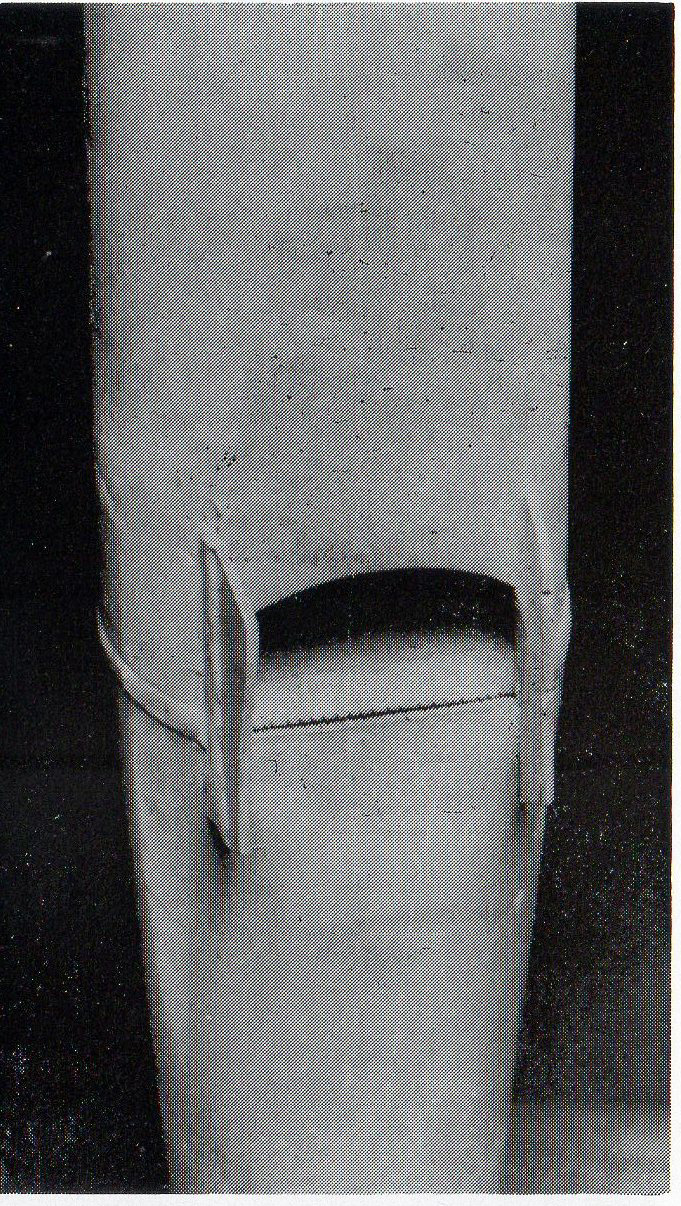
|
Mouth
of A sharp of
Choir Organ,
Orchester Flöte
Internal
width of pipe 140 mm
Internal
depth of pipe 41 mm
Width of mouth 25 mm
Height of mouth 14 mm
|
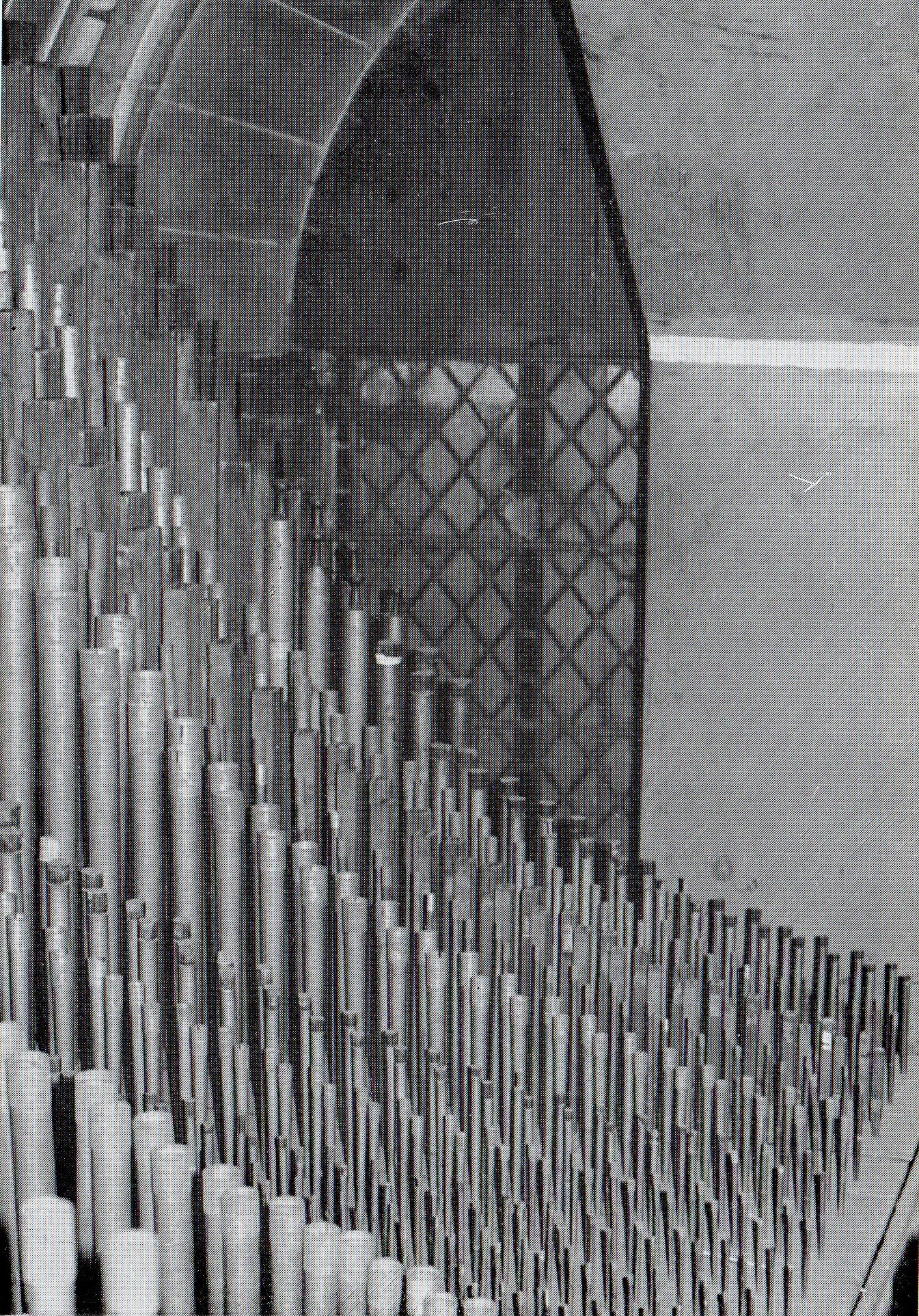
|
The
Echo Organ on only 1⅞ in. wind pressure, remains
unenclosed as Schulze left it and contains a wealth of delicate
and beautiful tones, some of which are barely audible in the
nave and make it possible to fade out almost to silence. The
Tibia Major 16ft., in spite of its curious name, is the softest
bourdon in the organ - "a mere breath of sound" as
described by Gilbert Benham, and very useful as a pedal bass
through the Echo to Pedal coupler added by Binns.
Left:
General view of the Echo Organ, placed against the north wall
of the transept. Pipes planted semitonally.
|
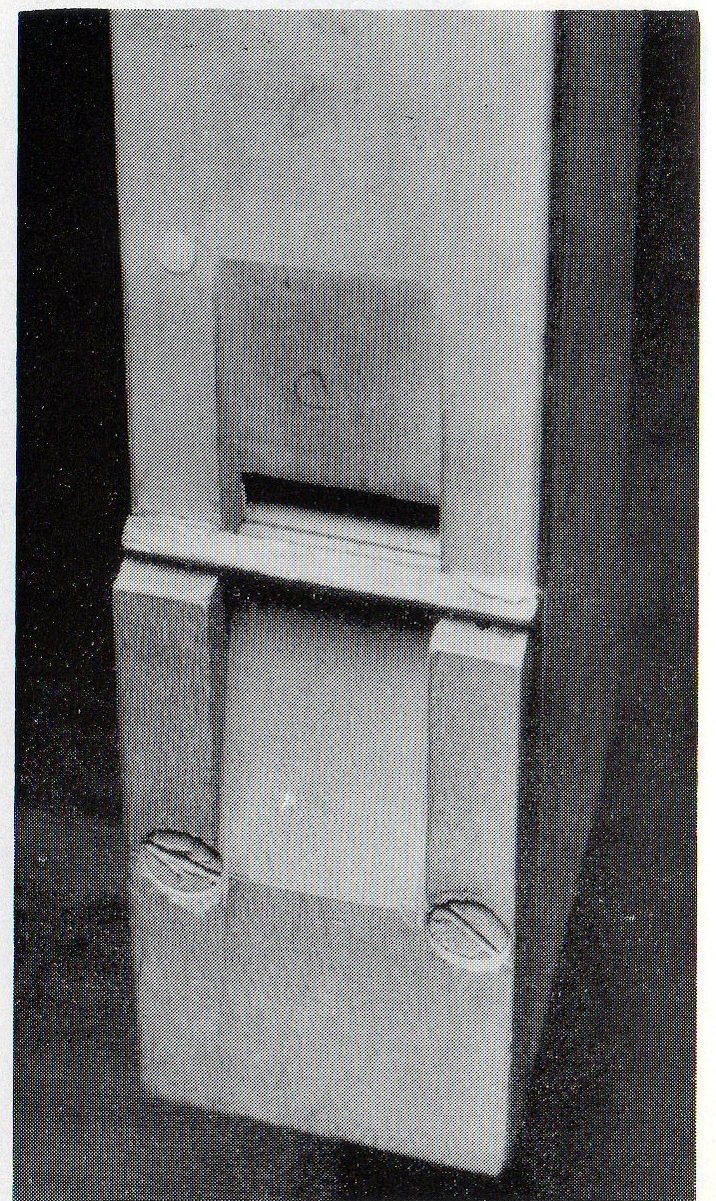
|
Left
- mouth of middle C pipe of
Echo Oboe, from Echo
Organ.
Note the very narrow flue. The pipe foot is
tipped with brass to facilitate exact regulation of the flow of
wind.
Foot hole diameter 3.2 mm.
Internal
width of pipe 19 mm Internal depth of pipe 39 mm
Width of
mouth 19 mm
Height of mouth 5.6 mm
|
The
Echo Oboe 8ft. was invented by Edmund Schulze when the Meanwood
organ was under discussion, and is a flue stop of wood
which Henry Willis I would not believe to be other than a reed
stop until he was shown the pipes!
Its
construction is fully illustrated by G. A. Audsley in "The
Art of Organ-building" and the tone is described as "somewhat
plaintive in character and exquisitely sweet." The Nasard
2⅔ft. and Flautino 2ft. are fortunately independent stops,
both of tapered open metal pipes.
The
early specifications and Binns' record for the rebuild of 1905 all
state that the Echo Organ was on only 1½ in. wind. This
pressure corresponds with those of the Echo divisions at Doncaster
Parish Church (1⅝ in.) and Leeds Parish Church in 1899 (1½
in.), both by Schulze. Mr. J. T. Jackson found the present value
of 1⅞ in. inscribed behind the music desk of the present
console at Armley and considers that this pressure has existed for
at least 25 years. He suggests that the Echo Organ pressure was
raised by Binns during the 1905 rebuild because the power motors
of his tubular-pneumatic action would not function adequately on
1½ in. wind. Similarly, at Leeds Parish Church, when the
Echo Organ was removed to the north-east corner of the chancel
during the 1913 rebuild by Harrison & Harrison (to become the
Altar Organ), the pressure had reached 3 in., the action then
necessarily being electro-pneumatic. If the action of the Armley
Echo Organ is restored to tracker operation, an opportunity will
arise to restore the original wind pressure.
Tremulants
were added to the Choir, Swell and Echo Organs by Binns in 1905,
and these three divisions (as also the Great Organ for one stop
only) have "grooving" on the soundboards, by which a
rather doubtful economy in pipes was effected, the stops in
question sharing a common bass octave. In the large Schulze Pedal
Organ at Doncaster Parish Church, many of the higher-pitched stops
are derived in part from parent stops by the use of this method.
Mouth
of middle C pipe of Pedal Organ, Violincello.
Internal
width of pipe 30 mm
Internal depth of pipe 30 mm
Width
of mouth 30 mm
Height of mouth 6.4 mm
|
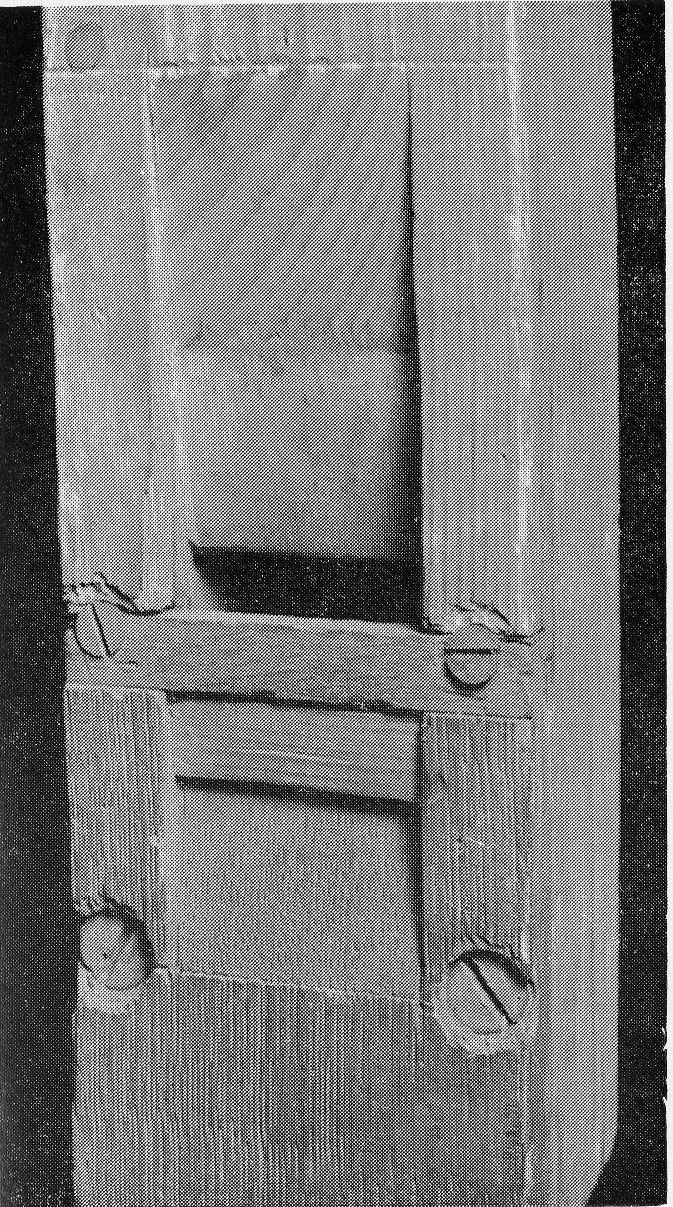
|
The
Pedal Organ of twelve stops contains no instance of
borrowing or extension and is complete, except for the lack of
a mixture, from the 32ft. open Sub Bass to the Octave 4ft.,
with reed stops of 16ft. and 8ft. pitch, the whole being
greatly independent of the manual-to-pedal couplers and showing
the same clarity of tone and capability of blend so noteworthy
in the manual departments. The very effective Sub Bass 32ft.
and Metal Principal 1 Bass (now named "Open Metal")
of 16ft. pitch were added by Schulze & Sons, as already
described, when the organ was presented to the church. The
former stop, owing to the mistake on its insertion, is now one
pipe too large in scale and the latter stop, being of large
scale, of great richness and "in prospect", adds much
to the majesty of the Pedal section. The Principal Bass 16ft.
was the original major pedal stop at Meanwood and at Harrogate.
It is of wood, definite in tone, but only of moderate power,
which is increased when the Quinte 10⅔ ft. is added,
rather than creating a marked 32ft. resultant pitch. The
Octaves 8ft. and 4ft., the latter only of metal, are bold stops
defining the pedal line in forte passages.
The
Violon 16ft. and Violoncello 8ft. are fine examples of
Schulze's genius in voicing string-toned pipes. Both are of
wood, the former giving fine pizzicato effects, the latter
being of exquisite quality and considerable power (Left).
The two reed stops are free in tone, being similar to those of
the Great Organ, but of greater power and add much to the
effect of Full Pedal Organ.
|
The
question may be asked "Why is the Armley Schulze organ unique
in England, since Edmund Schulze built several complete organs for
churches in this country and inserted stops in organs by other
builders, in addition to smaller instruments for private owners
and the large Meanwood organ?
A
reply to this question, which is fundamental to the perceived
importance of the St. Bartholomew’s organ, must first recall
the history of the other surviving Schulze organs in the U.K. In
two of these instruments, at St. Peter's Church, Hindley,
Lancashire, and at Leeds Parish Church, (now
Leeds Minster), the Schulze pipes were revoiced by subsequent
organ-builders, who were themselves artists, in order to adjust
for increased wind pressure required by added pneumatic actions,
or to accommodate the stops in an entirely different tonal scheme.
Thus the original Schulze tone was lost forever in the case of the
fine Open Diapason at Leeds and in the metal pipes of the
Diapasons at Hindley.
In
the largest Schulze organ in England, at Doncaster Parish Church,
the diapasons are of an earlier type, additional stops
have been added, the Echo Organ has been enclosed in a swell box
and the instrument is in an unfavourable position behind an
indifferent "case." The acoustics of the church being
unsympathetic to organ tone.
That
life-long student and admirer of Schulze's work, the Rev. Noel A.
Bonavia-Hunt, considered that at Meanwood (now transferred to
Armley) and at St. Mary's Church, Tyne Dock, South Shields,
Schulze brought to fruition his ideal of diapason tone, as suited
to a building of cathedral proportions, and that at St.
Bartholomew's Church, Armley, the most perfect combination of
ideal acoustics and beauty of voicing has been realised in an
instrument almost untouched by the hands of later voicers - a
unique situation which has arisen by a strange series of
events.
Thus
the St. Bartholomew’s Schulze Organ tone has, uniquely,
survived and must be preserved for future generations to hear and
enjoy.
This
is the end of Kenneth Johnstone’s book -
first
published in 1978 and revised by Kenneth for a second edition in
1985.
|
|
|
